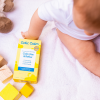So Many Infant Formulas, Which One to Choose for Colic, Gas & Reflux?

When you have a baby suffering from colic, gas, or reflux, as a parent, you are willing to try anything to ease their pain. You constantly question yourself: “Am I using the right formula? Am I feeding her too much/too little? Is there a different bottle I should be using? Should I be burping her differently?” And when you turn to Google, you are bombarded with advertisements, mommy blogs, and medical websites all touting different products, information, and advice. It’s hard to know what’s right and what’s not.
Babies suffer from gas, bloating, and reflux because their little esophagus and digestive tract are still learning how to perform. It’s important to identify whether your baby is suffering from normal reflux and gas versus the more serious symptoms of reflux, GERD, or Silent GERD. You can read more about these here. If it is one of the more serious types, you will work with your child’s pediatrician, and medication will most likely be involved. If you suspect your child’s symptoms fall within the more normal range, there are a few things you can address, one of which being the formula they are ingesting on a daily basis.
What should I look for in an infant formula?
You may notice your baby typically shows symptoms of colic, gas, or bloating after feedings. If your little one is formula fed, or if you supplement breastfeeding with infant formula, one of the first things to examine is the type of formula you’re using. There seem to be an infinite number of brands and types, powders vs ready-to-use, organic vs non-organic, vitamin or iron fortified, cow or soy based, and list goes on.
The first step is to consult with your child’s pediatrician. They are the most up-to-date on what’s new, what’s working and what isn’t, and can recommend a brand and type of formula to try first. After that, it can turn into a game of trial and error while you watch and see how your baby reacts after feedings.
Armed with a few brands to examine, the next thing you should do is to look at the ingredients. There are many seemingly foreign ingredients in infant formula making it difficult to know what you should be looking for. Inspect your baby’s formula for the type of protein, lactose content, vitamins and minerals included, fatty acids, and carbohydrates, to name just a few. WebMD has a fairly comprehensive article about what to look for when selecting a formula for your child.
Sugars in infant formula – are they all bad?
One of the most concerning ingredients found in formula is sugar. It can appear in infant formulas in a variety of forms. Are all sugars bad and is it possible to find a formula containing no sugars? The short answer is no, not all sugars are bad, but let’s take a look at why sugars are included in infant formula in the first place and why there is confusion around the inclusion of these ingredients.
When looking at formula ingredients, you may see one of these types of sugars on the list: •Corn syrup* : Breaks down as a glucose.
• Corn syrup solids*: Dehydrated corn syrup.
• Corn maltodextrin: A more complex version of corn syrup.
• Glucose syrup: When you see glucose syrup on an ingredient list, it is most likely corn syrup, but companies often list it under this more generic name.
• Brown rice syrup: Usually found in organic formulas and is essentially the same as corn syrup, a glucose, but is derived from rice instead of corn.
• Sucrose : Chemical name for table sugar.
• Rice starch: Typically used to thicken formula.
*(It is important to note that corn syrup and corn syrup solids are not the same as high fructose corn syrup. Corn syrup breaks down as a glucose, unlike high fructose corn syrup, which is fructose, a possibly harmful substance that even adults should monitor.)
According to this article, “These ingredients are not considered added sugars like they would be in cookies. They serve as carbohydrates, which your baby needs for energy and growth. Babies can't digest complex carbohydrates like fiber, so the carbs in formula need to be simple and easily broken down.”
Nearly all formulas on the market contain some sort of added sugar. Sugars are often found as carbohydrates in formula because they are easier to digest than lactose, a reason why they are found most commonly in the “easy-to-digest” and “lactose-free” formulas. They are also included to make the formula taste better and more like breastmilk.
Not all sugars are created equal. Of the sugars mentioned, sucrose is one that should most likely be avoided as it is essentially table sugar and contains fructose. The levels of these ingredients should also be noted when doing your research; too much sugar can be detrimental.
Which formula is “right?”
There is no right or wrong formula. What works for your baby may not work at all for another. If your main concern when searching for a formula is sugar content, then look for one with a high lactose content as the main carbohydrate. If you’re looking to find the best formula for colic, gas, or reflux, you may have to select a formula that has a balance of both lactose and one of these more digestible ingredients in order to provide your baby with relief.
One thing to remember is to give your little one time to get used to one formula before switching to another. Most pediatricians recommend sticking with one type of formula for at least a week before changing it again in order to give your baby time to adjust.
Are there other options to treat colic, gas, and reflux?
Don’t want to disrupt your routine with a new formula quite yet? Common remedies include feeding your baby smaller amounts of food more slowly, burping more often, elevating their head during feeding, holding them upright for 30 minutes after feeding, or using a bottle designed to eliminate air bubbles.
Another option to consider isn’t actually a formula at all, but is commonly used to treat colic, gas, bloating, and reflux. A gripe water such as Colic Calm can be used in instances to relieve symptoms that may not be chronic, but still require much needed relief.Vegetable charcoal, the key ingredient in Colic Calm, is an inactive material that passes through the intestines without being absorbed itself. On its way, it adsorbs gases, thus relieving bloating and gas pains. It’s a homeopathic, all natural option that’s gentle on your little one’s tummy and offers fast relief.
Ultimately, you have to select a formula or solution that works best for your child, and no one will be a better judge of what’s working and what’s not than you. Even though you may feel like you are in a hopeless situation when your baby is crying at 2am in the morning with gas or bloating, take comfort in the fact that the symptoms that keep both you and your baby up at night will eventually pass. Hang in there parents, you’re doing a great job!
 Canada
Canada South Africa
South Africa UK
UK EU & Int
EU & Int Ireland
Ireland Australia
Australia Brazil
Brazil New Zealand
New Zealand


















Comments